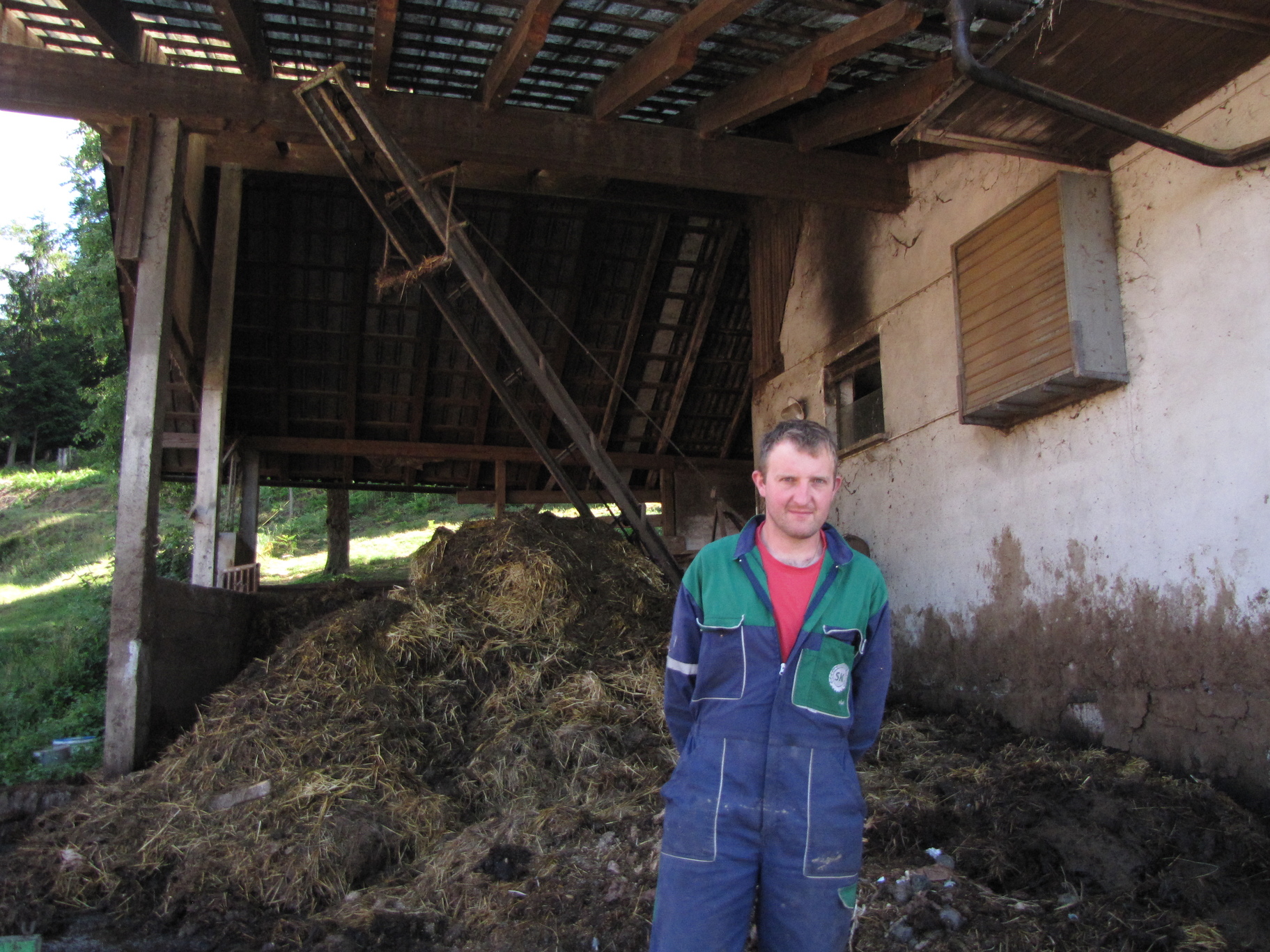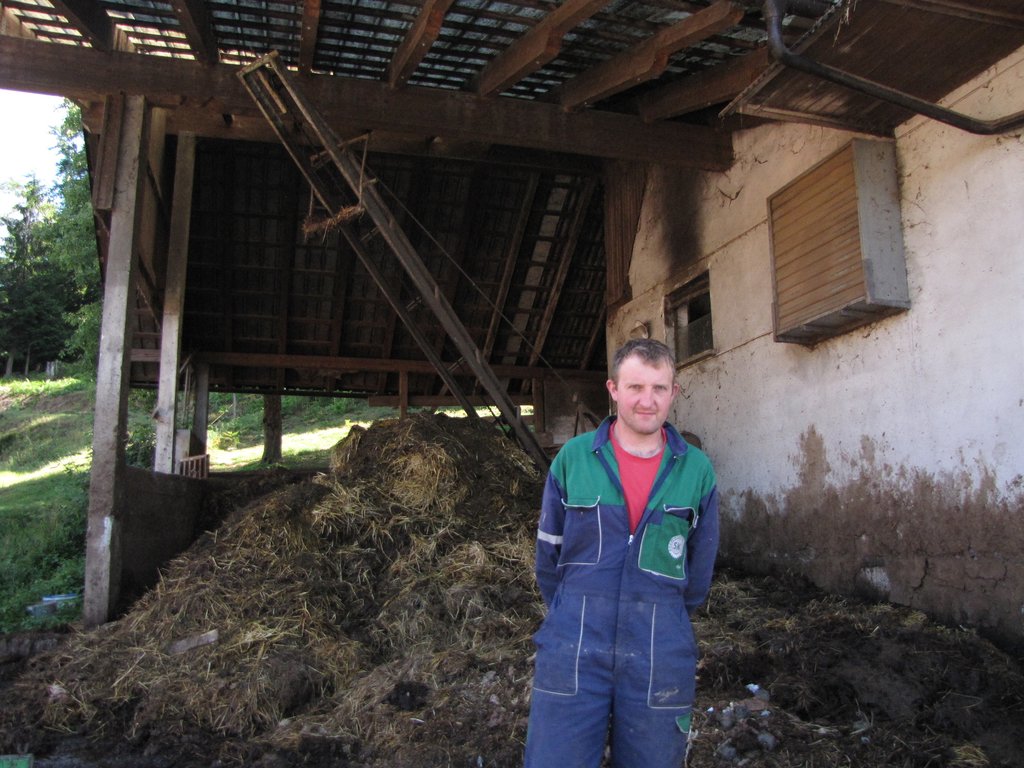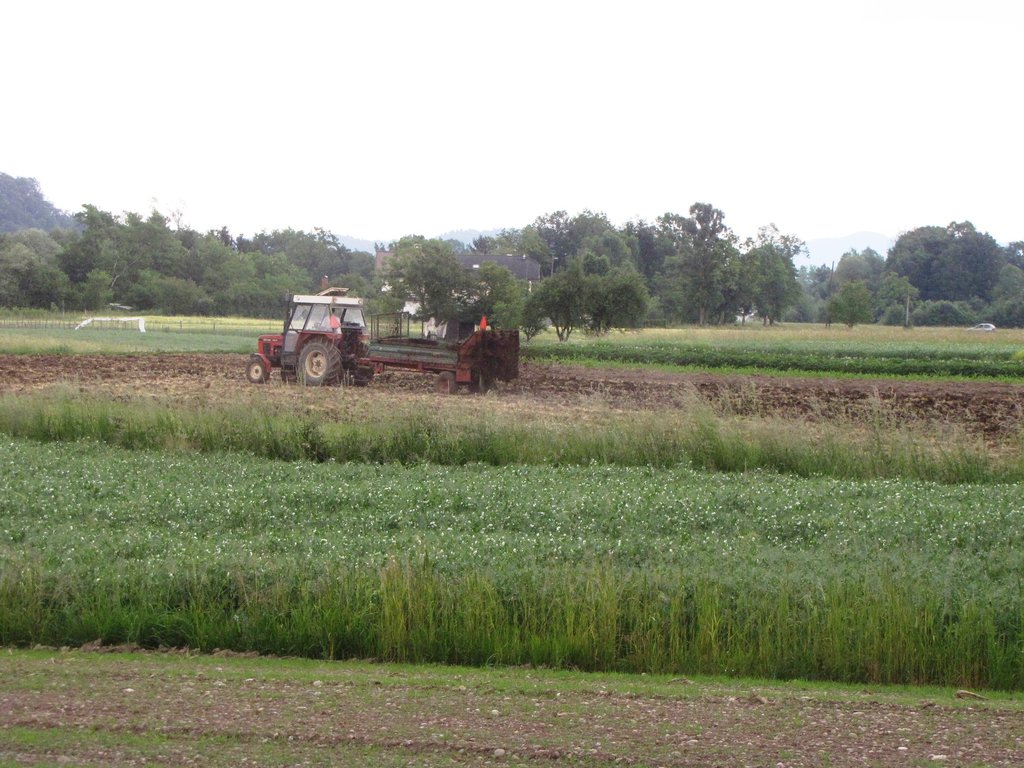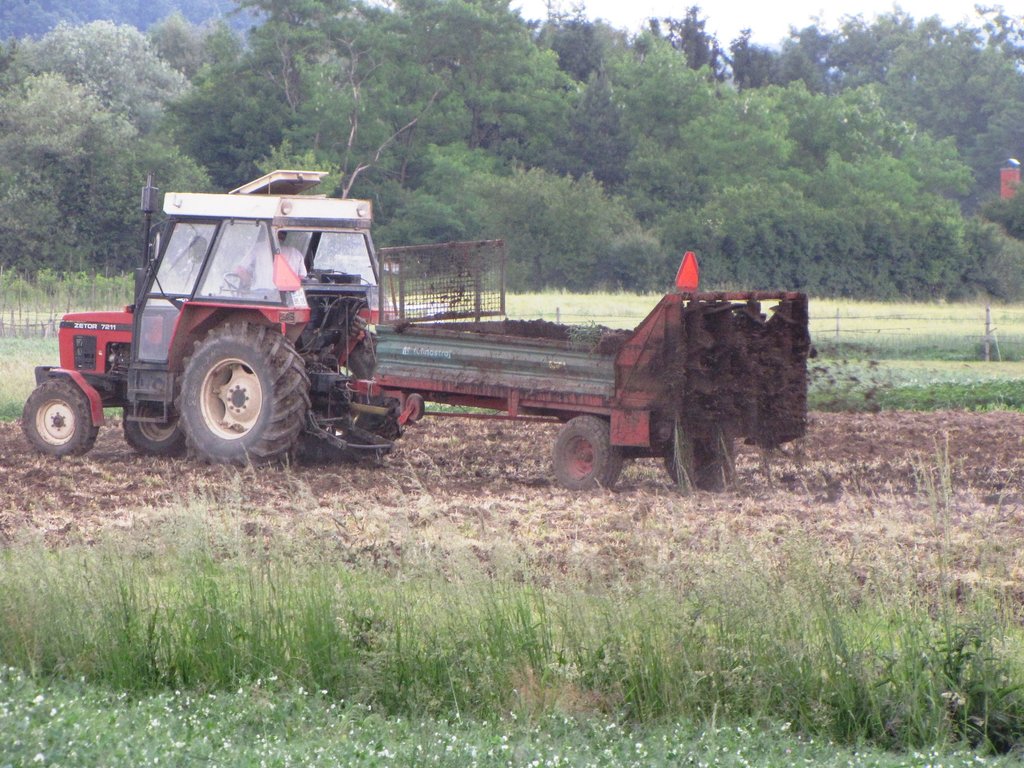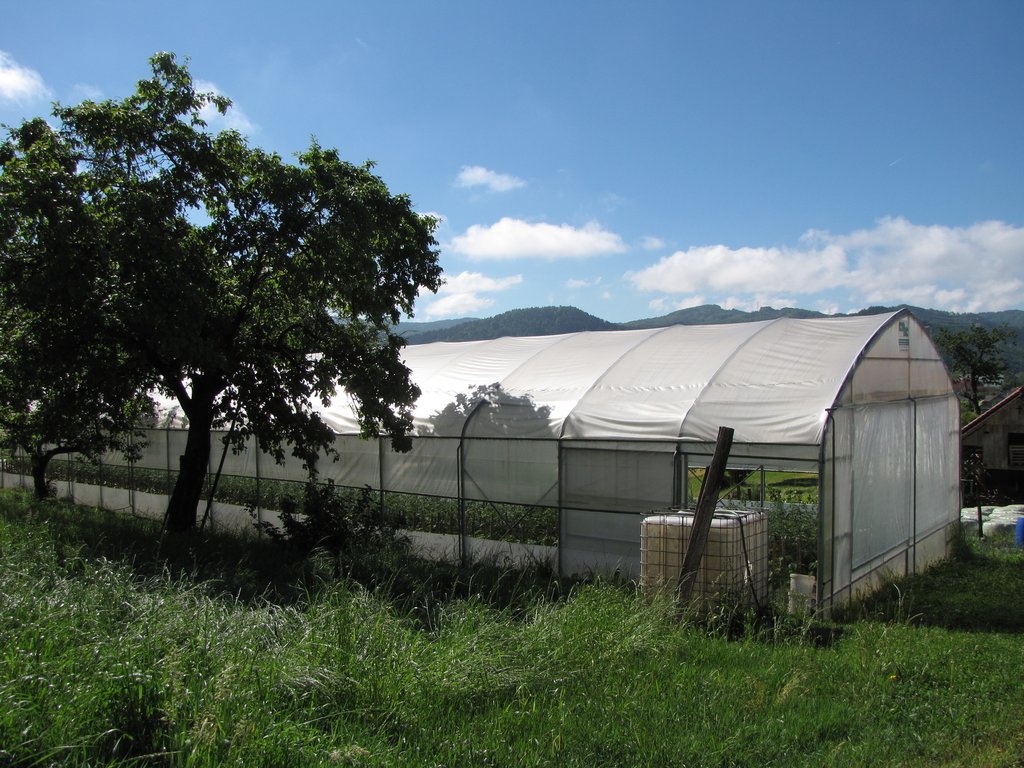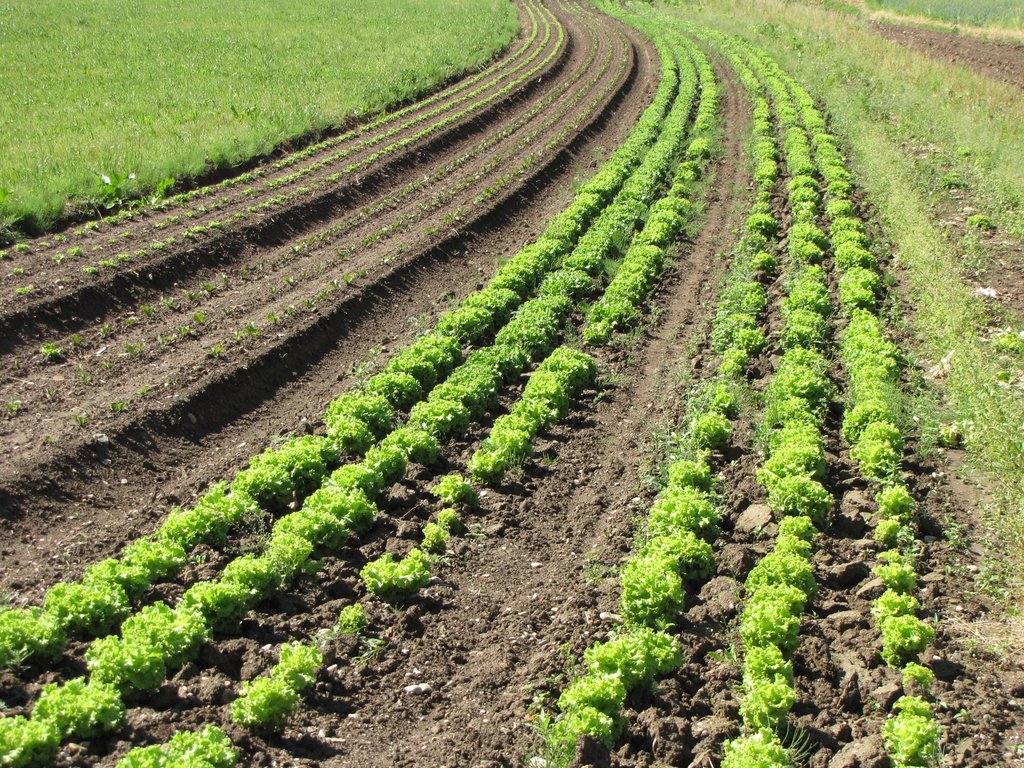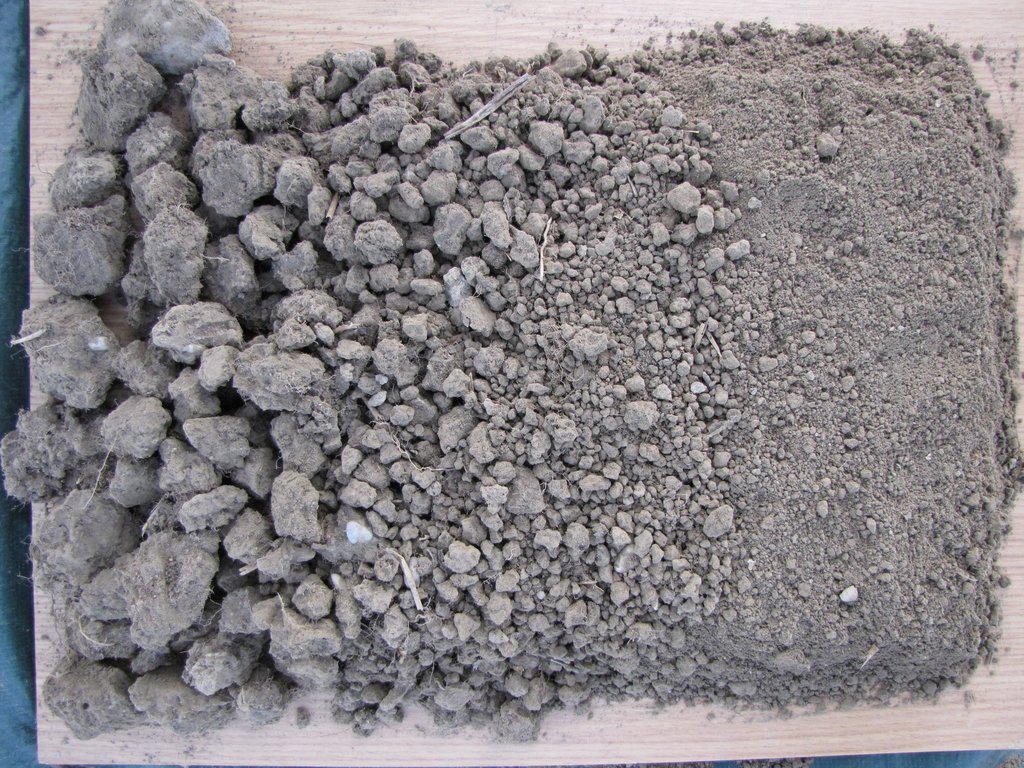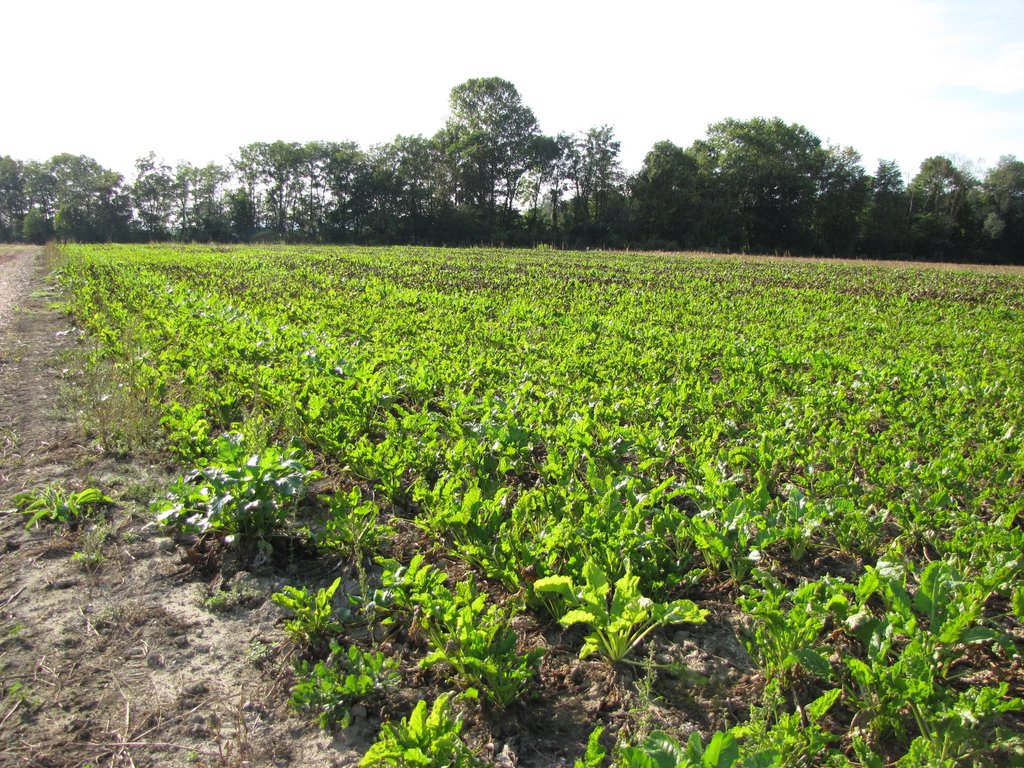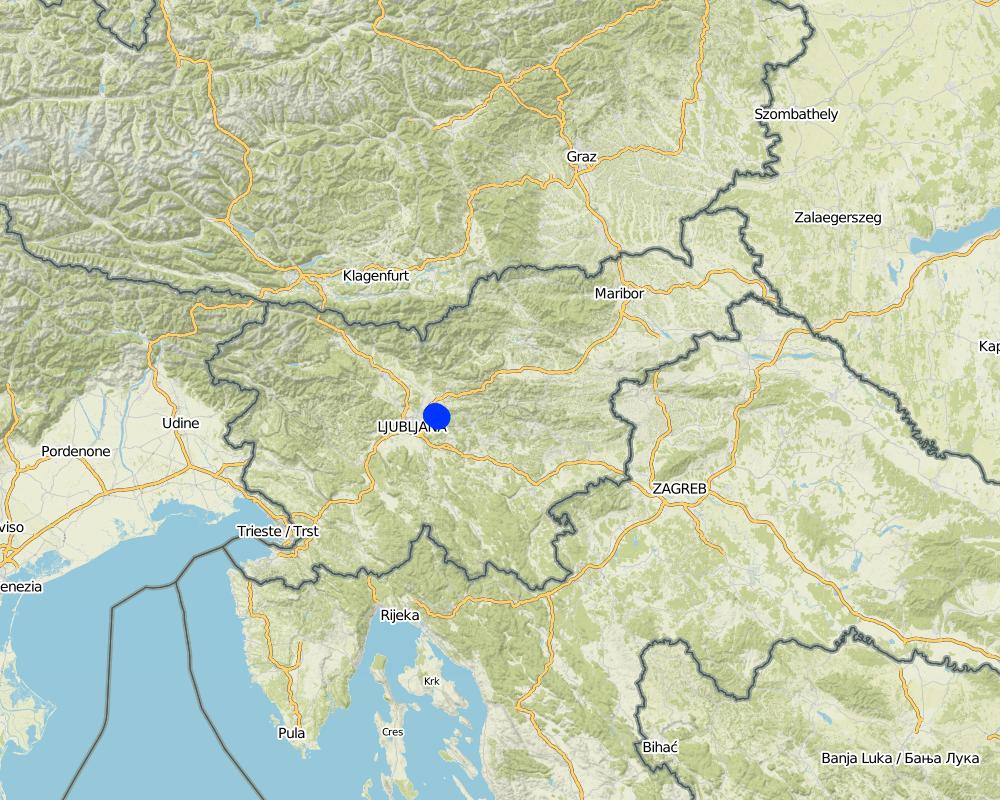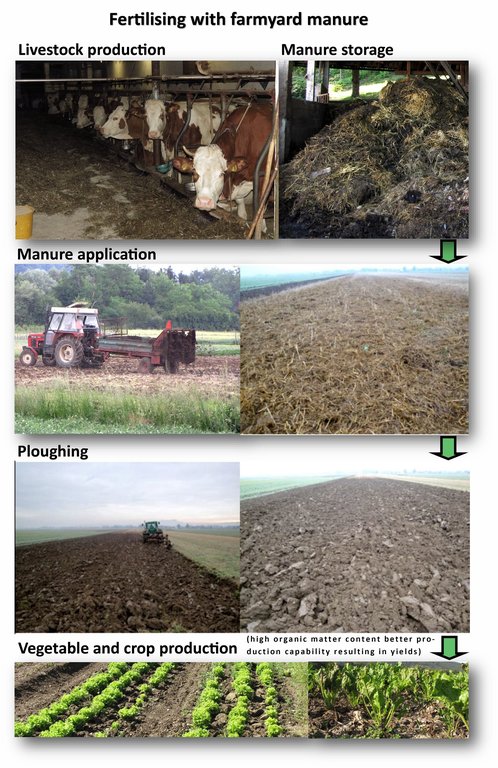Fertilising with farmyard manure [Slovenia]
- Creation:
- Update:
- Compiler: Matjaz Glavan
- Editor: –
- Reviewers: Ursula Gaemperli, Gudrun Schwilch
Gnojenje s hlevskim gnojem
technologies_2824 - Slovenia
View sections
Expand all Collapse all1. General information
1.2 Contact details of resource persons and institutions involved in the assessment and documentation of the Technology
Name of project which facilitated the documentation/ evaluation of the Technology (if relevant)
Interactive Soil Quality assessment in Europe and China for Agricultural productivity and Environmental Resilience (EU-iSQAPER)Name of the institution(s) which facilitated the documentation/ evaluation of the Technology (if relevant)
Department for Agronomy, University of Ljubljana - Slovenia1.3 Conditions regarding the use of data documented through WOCAT
When were the data compiled (in the field)?
09/06/2017
The compiler and key resource person(s) accept the conditions regarding the use of data documented through WOCAT:
Yes
1.4 Declaration on sustainability of the described Technology
Is the Technology described here problematic with regard to land degradation, so that it cannot be declared a sustainable land management technology?
No
2. Description of the SLM Technology
2.1 Short description of the Technology
Definition of the Technology:
The technology is based on use of livestock manure from dairy cows (excreta and cereals straw) for fertilisation of arable fields with 3-5 year rotation. Manure has a very good effect on soil production capacity and on growth of vegetable crops.
2.2 Detailed description of the Technology
Description:
1. The technology is applied in the flatlands of Ljubljana with an average altitude of 350 m.a.s.l. Average annual precipitation is 1400 mm. The area is characterized with often stormy precipitation events and occasional droughts. Silty loam soils in the area are moderately deep to deep with medium soil organic matter. Area has good availability of surface water and groundwater of good drinking quality. The biodiversity of the area is medium without any salinity and flooding problems. Sedentary agriculture with mixed or commercial agriculture is practiced with less than 10% of income coming from off-farm activities. The examined farm household has an average wealth and is fully mechanized/motorized. All farm households have a good access to services and infrastructure. The examinded farm is medium in scale with land patly owned by the land user and partly leased from other private owners.
2. Main characteristic is the use of livestock manure on arable fields and especially for vegetable production. Manure is composed from solid dairy cows excreta and cereals straw (wheat, barley) which is used as bedding for cows. Manure is composted for few months (4-6, depends on storage capacity). It is spread before ploughing and then ploughed into the soil. Spreading of manure is done in autumn or in spring. Knowledge on time of spreading and on handling with machines is needed.
3. Main function is increasing organic matter in the soil and also all major nutrients (nitrogen, phosphorus, potassium, magnesium, calcium etc.). This leads to better (1) productivity due to nutrients slow release, (2) better water holding capacity and (3) decreased soil compaction threat.
4. Major inputs needed to establish are: livestock (animals), stable adapted to the manure collection, use of straw bedding, storage facility (if possible covered with roof), manure spreader, and loading equipment. Major inputs to maintain are: keeping of the livestock herd and maintenance of the machines.
5. The benefits are: (1) increase in soil organic matter, (2) increase soil water holding capacity, (3) to maintain soil productivity, (4) increase in yields quantity and quality.
6. Land users like: (1) lower cost for mineral fertilisers, (2) impact on soil fertility, (3) it's a traditional method.
Land users dislike: (1) time-consuming - labour hours invested, (2) storage capacity takes space, (3) costs of transport.
2.3 Photos of the Technology
2.4 Videos of the Technology
Comments, short description:
.
2.5 Country/ region/ locations where the Technology has been applied and which are covered by this assessment
Country:
Slovenia
Further specification of location:
Municipality of Dol pri Ljubljani
Map
×2.6 Date of implementation
If precise year is not known, indicate approximate date:
- more than 50 years ago (traditional)
2.7 Introduction of the Technology
Specify how the Technology was introduced:
- as part of a traditional system (> 50 years)
3. Classification of the SLM Technology
3.1 Main purpose(s) of the Technology
- improve production
- reduce, prevent, restore land degradation
- create beneficial economic impact
3.2 Current land use type(s) where the Technology is applied

Cropland
- Annual cropping
Main crops (cash and food crops):
silage maize / winter barley / winter wheat / vegetable / potatoe / sugar beet
3.3 Further information about land use
Water supply for the land on which the Technology is applied:
- rainfed
Comments:
only vegetables are also irrigated
Number of growing seasons per year:
- 1
Specify:
one main crop
3.4 SLM group to which the Technology belongs
- integrated crop-livestock management
- integrated soil fertility management
3.5 Spread of the Technology
Specify the spread of the Technology:
- evenly spread over an area
If the Technology is evenly spread over an area, indicate approximate area covered:
- 0.1-1 km2
3.6 SLM measures comprising the Technology

agronomic measures
- A2: Organic matter/ soil fertility

structural measures
- S11: Others

management measures
- M7: Others
3.7 Main types of land degradation addressed by the Technology

chemical soil deterioration
- Cn: fertility decline and reduced organic matter content (not caused by erosion)

physical soil deterioration
- Pc: compaction
- Pk: slaking and crusting

biological degradation
- Bq: quantity/ biomass decline
- Bl: loss of soil life
3.8 Prevention, reduction, or restoration of land degradation
Specify the goal of the Technology with regard to land degradation:
- prevent land degradation
- reduce land degradation
4. Technical specifications, implementation activities, inputs, and costs
4.1 Technical drawing of the Technology
4.2 Technical specifications/ explanations of technical drawing
The infographic presents main parts of the technology from livestock originated manure, stored and composted and finally applied over fields. After that manure is incorporated in to the soil with purpose of improving the productivity of soils and for better crop and vegetable yields.
4.3 General information regarding the calculation of inputs and costs
Specify how costs and inputs were calculated:
- per Technology area
Indicate size and area unit:
28 hectares
other/ national currency (specify):
EUR (€)
Indicate exchange rate from USD to local currency (if relevant): 1 USD =:
0.89
Indicate average wage cost of hired labour per day:
50 EUR
4.4 Establishment activities
| Activity | Type of measure | Timing | |
|---|---|---|---|
| 1. | construction of the storage facility for capacity of 6 month | Structural | all year around |
| 2. | Purchase of machinery for manure loading | Management | all year around |
| 3. | Purchase of machinery for manure transport | Management | all year around |
Comments:
However, this is a traditional method, so farmer has mainly maintenance costs.
4.5 Costs and inputs needed for establishment
If possible, break down the costs of establishment according to the following table, specifying inputs and costs per input. If you are unable to break down the costs, give an estimation of the total costs of establishing the Technology:
2.0
| Specify input | Unit | Quantity | Costs per Unit | Total costs per input | % of costs borne by land users | |
|---|---|---|---|---|---|---|
| Equipment | Storage facililty for 6 month capacity | pcs | 1.0 | 10000.0 | 10000.0 | 100.0 |
| Equipment | Machine for loading manure | pcs | 1.0 | 10000.0 | 10000.0 | 100.0 |
| Equipment | Machine for transport of manure | pcs | 1.0 | 15000.0 | 15000.0 | 100.0 |
| Total costs for establishment of the Technology | 35000.0 | |||||
4.6 Maintenance/ recurrent activities
| Activity | Type of measure | Timing/ frequency | |
|---|---|---|---|
| 1. | Labour with daily manure handling | Agronomic | all year around |
| 2. | Labour with transport to the fields | Agronomic | all year around |
| 3. | Maintanance of machines | Agronomic | all year around |
4.7 Costs and inputs needed for maintenance/ recurrent activities (per year)
| Specify input | Unit | Quantity | Costs per Unit | Total costs per input | % of costs borne by land users | |
|---|---|---|---|---|---|---|
| Labour | Manure handling every day | EUR/hour | 182.5 | 6.25 | 1140.63 | 100.0 |
| Labour | Transport to the fields | EUR/hour | 30.0 | 6.25 | 187.5 | 100.0 |
| Equipment | Maintanance of machines | EUR/hour | 8.0 | 6.25 | 50.0 | 100.0 |
| Total costs for maintenance of the Technology | 1378.13 | |||||
4.8 Most important factors affecting the costs
Describe the most determinate factors affecting the costs:
Labour is the most important. It is followed by livestock herd. However, herd costs are covered with milk production.
5. Natural and human environment
5.1 Climate
Annual rainfall
- < 250 mm
- 251-500 mm
- 501-750 mm
- 751-1,000 mm
- 1,001-1,500 mm
- 1,501-2,000 mm
- 2,001-3,000 mm
- 3,001-4,000 mm
- > 4,000 mm
Specify average annual rainfall (if known), in mm:
1352.00
Specifications/ comments on rainfall:
Averegae rainfall period (1991-2000).
Majority of rain in autumn, followed by summer, spring and winter.
Indicate the name of the reference meteorological station considered:
Ljubljana - Bežigrad
Agro-climatic zone
- sub-humid
Strong summer tunder storms and showers. Local precipitation.
5.2 Topography
Slopes on average:
- flat (0-2%)
- gentle (3-5%)
- moderate (6-10%)
- rolling (11-15%)
- hilly (16-30%)
- steep (31-60%)
- very steep (>60%)
Landforms:
- plateau/plains
- ridges
- mountain slopes
- hill slopes
- footslopes
- valley floors
Altitudinal zone:
- 0-100 m a.s.l.
- 101-500 m a.s.l.
- 501-1,000 m a.s.l.
- 1,001-1,500 m a.s.l.
- 1,501-2,000 m a.s.l.
- 2,001-2,500 m a.s.l.
- 2,501-3,000 m a.s.l.
- 3,001-4,000 m a.s.l.
- > 4,000 m a.s.l.
Indicate if the Technology is specifically applied in:
- not relevant
5.3 Soils
Soil depth on average:
- very shallow (0-20 cm)
- shallow (21-50 cm)
- moderately deep (51-80 cm)
- deep (81-120 cm)
- very deep (> 120 cm)
Soil texture (topsoil):
- coarse/ light (sandy)
- medium (loamy, silty)
Soil texture (> 20 cm below surface):
- medium (loamy, silty)
Topsoil organic matter:
- medium (1-3%)
5.4 Water availability and quality
Ground water table:
5-50 m
Availability of surface water:
good
Water quality (untreated):
good drinking water
Is water salinity a problem?
No
Is flooding of the area occurring?
No
5.5 Biodiversity
Species diversity:
- medium
Habitat diversity:
- medium
5.6 Characteristics of land users applying the Technology
Sedentary or nomadic:
- Sedentary
Market orientation of production system:
- mixed (subsistence/ commercial
Off-farm income:
- less than 10% of all income
Relative level of wealth:
- average
Individuals or groups:
- individual/ household
Level of mechanization:
- mechanized/ motorized
Gender:
- men
Age of land users:
- middle-aged
5.7 Average area of land owned or leased by land users applying the Technology
- < 0.5 ha
- 0.5-1 ha
- 1-2 ha
- 2-5 ha
- 5-15 ha
- 15-50 ha
- 50-100 ha
- 100-500 ha
- 500-1,000 ha
- 1,000-10,000 ha
- > 10,000 ha
Is this considered small-, medium- or large-scale (referring to local context)?
- medium-scale
5.8 Land ownership, land use rights, and water use rights
Land ownership:
- state
- individual, titled
Land use rights:
- leased
- individual
Water use rights:
- individual
5.9 Access to services and infrastructure
health:
- poor
- moderate
- good
education:
- poor
- moderate
- good
technical assistance:
- poor
- moderate
- good
employment (e.g. off-farm):
- poor
- moderate
- good
markets:
- poor
- moderate
- good
energy:
- poor
- moderate
- good
roads and transport:
- poor
- moderate
- good
drinking water and sanitation:
- poor
- moderate
- good
financial services:
- poor
- moderate
- good
- poor
- moderate
- good
6. Impacts and concluding statements
6.1 On-site impacts the Technology has shown
Socio-economic impacts
Production
crop production
crop quality
fodder production
fodder quality
product diversity
Comments/ specify:
Organic manure is crucial in vegetable production. The examinded farm would already have stopped the livestock production but then he would lack manure as crucial component for the vegetable production. Few years ago the land user only produced raw milk but as market demand for vegetable increased he started with this type of production.
land management
Income and costs
expenses on agricultural inputs
farm income
diversity of income sources
Comments/ specify:
Organic manure is crucial in vegetable production. Few years ago the examined land user only produced raw milk but as the market demand for vegetable increased he started with this type of production too..
workload
Ecological impacts
Soil
soil moisture
soil accumulation
soil crusting/ sealing
soil compaction
nutrient cycling/ recharge
soil organic matter/ below ground C
Biodiversity: vegetation, animals
beneficial species
Climate and disaster risk reduction
drought impacts
Comments/ specify:
Farmer observed that soils with regular application of manure have better ability to retain soil moisture, reducing impacts of drought.
6.2 Off-site impacts the Technology has shown
groundwater/ river pollution
6.3 Exposure and sensitivity of the Technology to gradual climate change and climate-related extremes/ disasters (as perceived by land users)
Gradual climate change
Gradual climate change
| Season | Type of climatic change/ extreme | How does the Technology cope with it? | |
|---|---|---|---|
| seasonal temperature | summer | increase | well |
| seasonal temperature | autumn | increase | well |
| seasonal rainfall | summer | decrease | not known |
Climate-related extremes (disasters)
Meteorological disasters
| How does the Technology cope with it? | |
|---|---|
| local rainstorm | not known |
| local thunderstorm | not known |
| local hailstorm | not known |
Climatological disasters
| How does the Technology cope with it? | |
|---|---|
| heatwave | well |
| cold wave | not known |
| extreme winter conditions | not known |
| drought | well |
6.4 Cost-benefit analysis
How do the benefits compare with the establishment costs (from land users’ perspective)?
Short-term returns:
slightly positive
Long-term returns:
slightly positive
How do the benefits compare with the maintenance/ recurrent costs (from land users' perspective)?
Short-term returns:
slightly positive
Long-term returns:
slightly positive
6.5 Adoption of the Technology
- more than 50%
Of all those who have adopted the Technology, how many have did so spontaneously, i.e. without receiving any material incentives/ payments?
- 90-100%
Comments:
Traditional method.
6.6 Adaptation
Has the Technology been modified recently to adapt to changing conditions?
No
6.7 Strengths/ advantages/ opportunities of the Technology
| Strengths/ advantages/ opportunities in the land user’s view |
|---|
|
Strengths: Mitigates drought. Use of mineral fertilisers is decreased. If fields are fertilised with organic livestock manure, the impact of spring drought on plant growth is minimal. |
|
Opportunities: Livestock manure is a basic fertiliser for vegetable production. Customers are asking farmer what he is using for fertilisation. They trust more to the product if it is fertilised with organic manure produced at the farm. |
| Strengths/ advantages/ opportunities in the compiler’s or other key resource person’s view |
|---|
| Strengths: increased levels of organic content. |
| Slow release of nutrients. |
| Better water holding capacity, especially in early spring. |
6.8 Weaknesses/ disadvantages/ risks of the Technology and ways of overcoming them
| Weaknesses/ disadvantages/ risks in the land user’s view | How can they be overcome? |
|---|---|
| Weakness: Costs of labour | They are investing in to mechanisation of the process. |
| Weaknesses/ disadvantages/ risks in the compiler’s or other key resource person’s view | How can they be overcome? |
|---|---|
|
Weaknesses: More labour work. |
Investing in machines with larger capacity |
| Risk: uncontroled release of nutrients into groundwater | They have to put lower quantity of more manure at one spreading. If they have vegetable production they can add two or three times in a year. |
7. References and links
7.1 Methods/ sources of information
- field visits, field surveys
1
- interviews with land users
1
Links and modules
Expand all Collapse allLinks
No links
Modules
No modules


